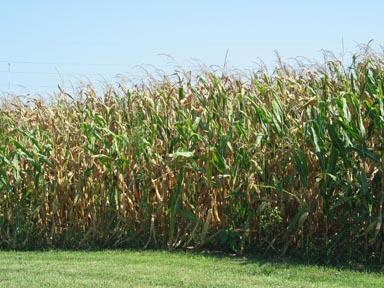Hot, Dry Weather Continues to Take Toll on Crops
Hot, Dry Weather Continues to Take Toll on Crops

Lack of moisture from a severe drought across the state and extreme August heat are taking a toll on corn and soybean crops. As a result, yields are expected to be reduced and harvest may be more challenging.
At the end of July crop prospects for the state were already showing lower anticipated yields compared to 2006 because of persistent dry weather. As much of Kentucky moves into its third week of temperatures above 90 degrees, heat is only adding to the problem, with crop conditions further declining on the weekly state crop and weather report issued by the Kentucky field office of the National Agricultural Statistics Service.
Much of the state’s soybean fields are in the critical pod and seed-fill stages of development and are in need of lower temperatures and rainfall to develop properly. Otherwise, they will likely develop smaller beans and may not develop all the beans in the pods, said Jim Herbek, extension grains crop specialist with the University of Kentucky Cooperative Extension Service.
For soybeans that are still blooming and setting pods, the weather is likely to cause more flower and pod abortions than normal. The extreme heat and dry conditions limit their reproductive ability, he said. Late-planted double-cropped soybeans have stopped growing and may not be worth harvesting if weather conditions don’t improve substantially within the next couple of weeks.
“The soybean crop could drastically decline if dry weather continues or improve greatly with rain,” Herbek said. “But we don’t need spotty showers. We need several soaking rains.” Corn yields are expected to be down 26 bushels per acre from last year’s 146-bushel state average. Corn’s yield drag is primarily due to lack of moisture. The severe drought conditions across the state in recent weeks likely have limited the crop from filling the kernels completely and will result in less yield and lower test weights, he said.
Corn yields are expected to be down 26 bushels per acre from last year’s 146-bushel state average. Corn’s yield drag is primarily due to lack of moisture. The severe drought conditions across the state in recent weeks likely have limited the crop from filling the kernels completely and will result in less yield and lower test weights, he said.
An added complication could be stalk integrity. Drought conditions most likely have weakened stalks and stands need to be checked prior to harvest, said Chad Lee, UK extension grains crop specialist.
“Corn plants require water to receive some nutrients from the soil,” Lee said. “In drought conditions, those nutrients cannot be pulled from the soil. If the roots are unable to take in nutrients, then the corn plant will pull nutrients from the stalks to fill out the kernels.”
This leaves the corn plant with poorer structural integrity making them more likely to fall over with heavy winds or heavy rains. Ear drop from these stalks is also more likely.
Farmers need to scout their fields to check for stalk problems. They can do this by grabbing stalks above the ear and pulling it about 10 to 12 inches from the center. If it returns to its normal, upright position, then stalk strength is acceptable. If it fails to return to the normal position, then weak stalks are likely to be a problem.
“Farmers need to be prepared to harvest fields as soon as moisture levels in the grain are acceptable,” Lee said. “Corn may need to be harvested wet and dried to 15 or 14 percent moisture.”
